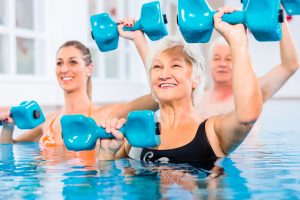
There are many ways that you can help prevent and even reverse bone loss. Usually, weight-bearing exercise is recommended for increasing bone density. In weight-bearing exercises, you are supporting your own body weight using your feet and legs—jogging, running, walking, and jumping are good examples. These activities increase bone density by having the muscle pull on the bone through impact on the ground and from carrying your body weight.
But a recent study done by The University of Sydney, Australia, and colleagues shows that other non-weight-bearing exercises could also help prevent bone loss. (Calcium does very little to prevent bone fractures.)
The reason for this study was that, while high-impact and mechanical loading have been linked to increased bone density, these types of exercises may not always be appropriate for middle-aged and older adults who are (a) not at their physical best and (b) usually suffer from conditions like osteoarthritis or some sort of degenerative muscle disease.
Water exercises to keep your bones strong
The objective of the study was to see if water-based exercises could be effective in preventing age-related bone deterioration in middle-aged and older adults. As part of the study, the researchers used relevant databases and conducted a string of critical narrative synthesis and meta-analyses from 12 studies involving 629 participants.
All the participants in the study were postmenopausal women (which incidentally is the group with the highest risk for osteoporosis). The researchers divided the participants into three groups. One group was subjected to water-based exercises. Another group was subjected to land-based exercises, and the third group was not subjected to any exercise (sedentary). (Thanks to strontium, it’s never too late to rescue your bones.)
Of the twelve studies, eight studies compared participants in the water-based exercise group to the sedentary control group, and four studies compared the water-based exercise group to the participants in the land-based exercise group.
At the end of the study, the researchers found that the participants in the water-based exercise group showed better bone mineral density at the lumbar spine and the neck of the femur (thigh bone) compared to the sedentary control group.
While the participants in the land-based exercise group showed better bone mineral density in the lumbar spine, the neck of femur showed no significant difference in both the groups.
From this study, it becomes clear that while land-based exercises are better than water-based exercises in helping prevent bone loss, for people who cannot do land-based exercises, the water-based exercises are a great option. So go ahead and make a splash.
Also read: 16 muscular system diseases you should know about